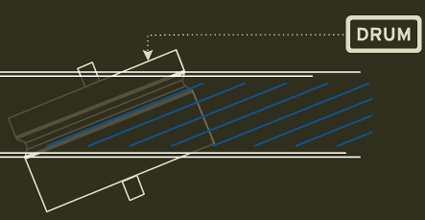The Last Resort: Streamer Technolgy Overview
The Linear Method Or Helical Scan
The Helical scan uses the existing "space" best, but it is slower and more prone to disruptions than linear methods. Source: ExaByte.
Generally, there are two ways to write onto a magnetic tape: Either linear, meaning streamlined from front to back, or diagonally, a method known as Helical scan. In any case, several parallel tracks are written onto the tape in order to utilize the entire bandwidth for data storage.
The Helical scan was adopted from the video segment and is used most often in DAT systems and in AIT and VXA. As constant writing and reading is often not possible, Helical scan-based devices are much slower than models using linear methods (backhitching through fluctuating data streams). At the same time, they can use the existing tape more efficiently, meaning that the capacity per spatial unit is usually higher in Helical scan standards.
Similarly to VHS systems, the tape is pulled out of the cassette and placed around the spindle, which holds the writing and reading heads. Naturally, this procedure puts a major strain on the tape, more so than in linear recording, which permanently feeds to the tape in the cassette.
Get Tom's Hardware's best news and in-depth reviews, straight to your inbox.
Current page: The Linear Method Or Helical Scan
Prev Page Does Emergency Data Recovery Work Properly? Next Page Data Compression: Optimistic Specifications
Patrick Schmid was the editor-in-chief for Tom's Hardware from 2005 to 2006. He wrote numerous articles on a wide range of hardware topics, including storage, CPUs, and system builds.
